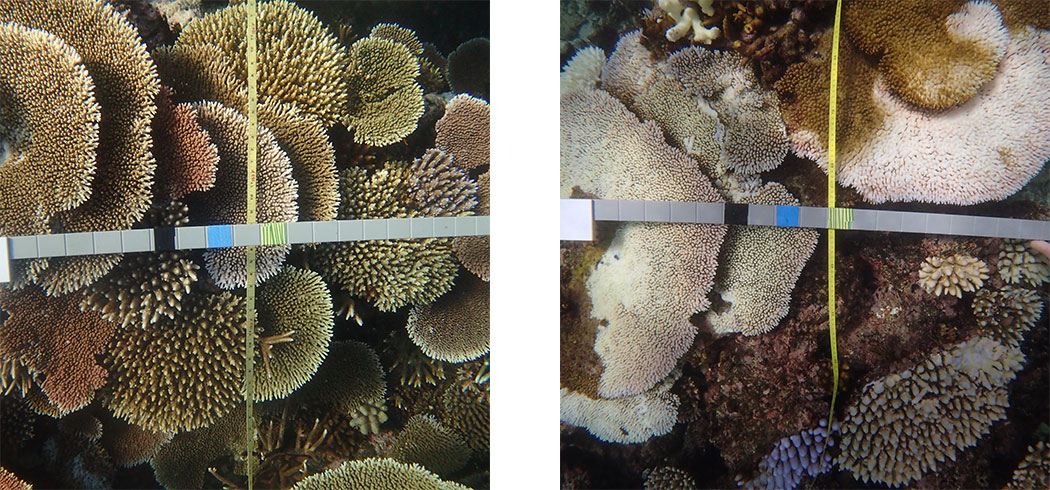Bleaching severity is varied on the central section of the Great Barrier Reef. Here, the shallow reef flat at Coates Reef just south of Cairns shows major bleaching (where 30-60% of the coral community is bleached). Image: N. Cantin / AIMS
AIMS scientists returned to Townsville this week after more than 3 weeks assessing bleaching on the GBR between Townsville and Port Douglas as part of the National Coral Bleaching Taskforce. Preliminary results indicate that while all surveyed reefs are experiencing bleaching in this region, the level of community-wide bleaching ranges from ’minor’ to ’extreme’. The scientists have also noted that the extent of bleaching differs between reefs and between species in the same location (see ‘Key Findings’ for further details). Detailing the variability of reef response and understanding why these differences exist among individual coral colonies within the same habitat will offer scientists unique insight into the bleaching ecology of corals, and contribute to AIMS’ ongoing research in this area.
Bleaching is varied between mid-shelf and inshore reefs, and from north to south
Scientists report that the bleaching severity on the central and northern GBR has varied between reefs. Mortality and severe bleaching was not observed until Saxon and Hastings Reefs near Port Douglas.
On reefs off the coast of Townsville, bleaching is generally restricted to the shallow, high-light environment of the reef flat (upper 1-3m, on top of the reef). Reefs experiencing this ’minor‘ level of bleaching (1-10% of coral community bleached) are typically less likely to experience major loss to the coral community.
On mid-shelf reefs along the coast from Mission Beach to Innisfail, bleaching levels are ’minor’ to ’moderate’ with less than 10-30% of the community bleached and bleaching restricted to the upper reef flat (1-3m).
AIMS researchers have observed an increase in bleaching severity on reefs north of Cairns, with extreme bleaching (more than 60% of the community) observed at Saxon and Hastings Reefs. Both of these reefs are reported to show bleaching of a wide range of species, extending beyond the reef flat to depths of 10-15m.
Bleaching severity within a coral community is measured along photo transects at each reef. Bleaching severity at Rib Reef (left) was recorded as ‘minor’ (<10% of the community bleached) and Hastings Reef (right) was recorded as ‘extreme’ (>60% of the community bleached). Images: N. Cantin / AIMS
The bleaching severity measured from these surveys is closely aligned with the aerial surveys conducted as part of the National Coral Bleaching Taskforce.
Bleaching is varied between species
In addition, scientists have observed that different species of coral have responded to the same local (that is, reef level) heat stress conditions in different ways. On reefs with ’minor’ bleaching, bleaching is somewhat restricted to coral types known to be more sensitive to thermal stress, such as Seriatopora, Stylophora and Pocillopora species (see below). Reefs exhibiting a ’moderate’ level of bleaching appear to impact a higher diversity of taxa including branching and plating Acropora species, some massive Porites, and a wide range of moderately tolerant sub-massive species including Goniastrea, Favia and Favites.
Bleaching responses vary between coral types. For example, corals such as Seriatopora (A), Stylophora (B) and Pocillopora (C) are more sensitive to heat stress than the more tolerant types such as Goniastrea (D), Favia (E) and Favites (F). Images: N. Cantin / AIMS
Bleaching is varied within species
Finally, field observations indicate that individual coral colonies from a single species can show remarkably different responses to heat stress. At Pandora Reef and Havannah Island, for example, AIMS scientists have tagged individual colonies of the same species showing a variety of responses - from ’no bleaching’, through to ’severely’ bleached, within the same habitat.
Investigating individual response patterns to environmental pressures such as rising sea surface temperatures is a valuable source of information that can augment AIMS’ long-term monitoring of coral health. It allows researchers the opportunity to understand factors that lead to thermal tolerance and assess how these factors drive recovery and rates of survival. In the coming weeks AIMS coral biologists will try to identify what traits are common among these individual colonies that aid in recovery.
Future monitoring
The total extent of mortality from this mass bleaching event will not be known for several weeks. As such, AIMS monitoring will resume in June to assess rates of recovery and mortality among the tagged individuals and within the reef community as a result of this years bleaching event.




